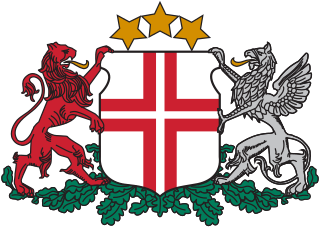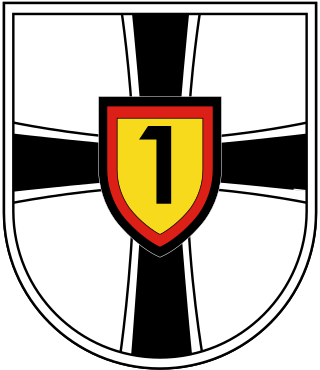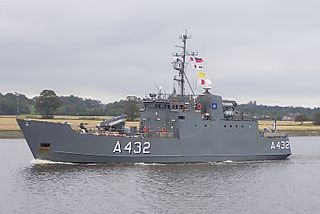
The Lithuanian Armed Forces are the military of Lithuania. The Lithuanian Armed Forces consist of the Lithuanian Land Forces, the Lithuanian Naval Force, the Lithuanian Air Force and the Lithuanian Special Operations Force. In wartime, the Lithuanian State Border Guard Service becomes part of the Lithuanian Armed Forces. A special security department handles VIP protection and communications security.

The Royal Danish Navy is the sea-based branch of the Danish Armed Forces force. The RDN is mainly responsible for maritime defence and maintaining the sovereignty of Danish territorial waters. Other tasks include surveillance, search and rescue, icebreaking, oil spill recovery and prevention as well as contributions to international tasks and forces.

The Finnish Navy is one of the branches of the Finnish Defence Forces. The navy employs 2,300 people and about 4,300 conscripts are trained each year. Finnish Navy vessels are given the ship prefix "FNS", short for "Finnish Navy ship", but this is not used in Finnish-language contexts. The Finnish Navy also includes coastal forces and coastal artillery.

Standing Royal Navy deployments is a list of operations and commitments undertaken by the United Kingdom's Royal Navy on a worldwide basis. The following list details these commitments and deployments sorted by region and in alphabetical order. Routine deployments made by the Navy's nuclear-powered submarines and their location of operations is classified.

The Commander-in-Chief Fleet (CINCFLEET) was the admiral responsible for the operations of the ships, submarines and aircraft of the British Royal Navy from 1971 until April 2012. The post was subordinate to the First Sea Lord, the professional head of the Naval Service. In its last years, as the Navy shrank, more administrative responsibilities were added.

Standing NATO Maritime Group One (SNMG1) is one of NATO's standing naval maritime immediate reaction forces. SNMG1 consists of four to six destroyers and frigates. Its role is to provide NATO with an immediate operational response capability.

The Estonian Navy are the unified naval forces among the Estonian Defence Forces.

HMS Shoreham was a Sandown-class minehunter of the British Royal Navy. She was the fifth vessel to bear the name. From 2018 to 2021, Shoreham was deployed at UKNSF Bahrain together with three other mine countermeasures ships as part of 9 Mine Countermeasures Squadron on Operation Kipion. In 2022 she was decommissioned and was transferred to Ukraine.

EMLAdmiral Pitka (A230) was a Beskytteren-class ocean patrol vessel and former flagship of the Estonian Navy, belonging to the Mineships Division. She was named after Estonian Admiral Johan Pitka.

EML Admiral Cowan (M313) is a Sandown-class minehunter. Formerly HMS Sandown, lead ship of her class of the Royal Navy, she is now an Estonian Navy ship. Renamed EML Admiral Cowan, she is the flagship of the Estonian Navy and part of the Estonian Navy's mine sweeping flotilla. Admiral Cowan is the lead vessel of the Estonian Navy Mineships Division and also the first of the three modernised Sandown class minehunters received.

The Estonian Mineships Division was the main Estonian Naval Unit and the part of Estonian Navy. The top priority for the Navy is the development of a mine countermeasures capability, as that is also one of the Navy's peacetime responsibilities: during World War I and II more than 80,000 sea mines were laid in the Baltic Sea. Since 1995 a number of mine clearance operations have been carried out in Estonian waters in close co-operation with other navies of the Baltic Sea region in order to find and dispose of ordnance and contribute to safe seagoing. Estonian MCM vessels also participate in NATO naval exercises.

The Estonian Defence Forces is the unified military force of the Republic of Estonia. The Estonian Defence Forces consists of the Estonian Land Forces, the Estonian Navy, the Estonian Air Force, and the paramilitary Estonian Defence League. The national defence policy aims to guarantee the preservation of the independence and sovereignty of the state, the integrity of its land area, territorial waters, airspace and its constitutional order. Its main goals remain the development and maintenance of a credible capability to defend the nation's vital interests and development of the defence forces in a way that ensures their interoperability with the armed forces of NATO and European Union member states to participate in the full range of missions for these military alliances.

BALTOPS is an annual military exercise, held and sponsored by the Commander, United States Naval Forces Europe, since 1971, in the Baltic Sea and the regions surrounding it.

Latvian Naval Forces is the naval warfare branch of the National Armed Forces. It is tasked with conducting military, search and rescue operations, mine and explosive sweeping on the Baltic Sea, as well as ecological monitoring activities. The Naval Forces have participated in international NATO/Partnership for Peace operations and various exercises with great success. The main development priorities of the Naval Forces are to expand their activities within the Baltic States’ Ship Squadron BALTRON and to develop a Sea Surveillance System. They pay a great deal of attention to professionally specialized training and English-language teaching.
EGUERMIN is the Belgian-Netherlands Naval Mine Warfare school. This academic establishment provides training and education to Belgian and Netherlands Navy crewmembers in charge of minehunting, as well as to Naval Mine Warfare officers from NATO and PfP countries.

Allied Command Channel (ACCHAN) was one of three major North Atlantic Treaty Organization (NATO) commands from 1952 to 1994. Commander-in-Chief Channel was a Major NATO Commander (MNC).

Einsatzflottille 1 is one of the three brigade-level units of the German Navy, in addition to Einsatzflottille 2 and the Naval Air Command. It is based in Kiel, Schleswig-Holstein, and is under the head of the Navy Command, based in Rostock.

The Lindormen class is a class of two minelayers built for the Royal Danish Navy to replace the Lougen-class minelayers that dated from World War II. The Lindormen class was designed to lay controlled controlled minefields in the Baltic Sea during the Cold War as part of NATO's defence plan for the region. They were taken out of service by the Danish in 2004, put up for sale in 2005 and transferred to Estonia in 2006.

Elbe (A511) is the lead ship of the Elbe-class replenishment ships of the German Navy.

















